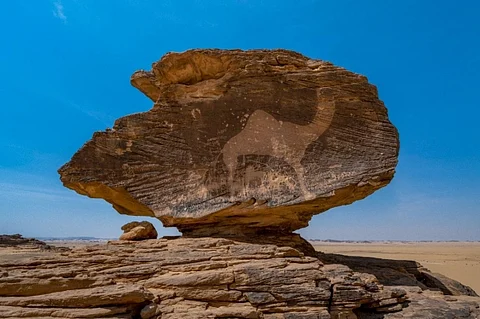

Hima a rock art site in Najran has been added to UNESCO's World Heritage List; becoming the sixth site to be enlisted in Saudi Arabia.
The site; which is located in southwestern Saudi Arabia; is home to one of the largest rock art complexes in the world.
Celebrating the occasion; Saudi Arabia's Culture Minister Prince Badr Bin Abdullah Bin Farhan lauded the support and guidance of Crown Prince Muhammad Bin Salman. He also thanked officials of the Heritage Commission; the Saudi mission to UNESCO and the Culture Ministry.
"Behind every cultural achievement is the guidance and vision of a great leader. Thank you to our inspiration; His Highness; the Crown Prince; for his constant support; and thanks go to my colleagues @MOCHeritage In the National Committee for Education; Culture and Science and in @MOCSaudi and in @KSAForUNESCO for their efforts and excellence."
Prince Badr thanked Bahrain; Oman and Kuwait for their support; also adding that "our country is rich in human heritage sites; and the future is always more beautiful".
He also thanked Egypt for always adhering to principles of Arab cooperation at every cultural forum.
Hima was a conduit for caravans on the trade and Hajj routes going to and further from the southern parts of Arabia; to the ancient world markets of Arabia; Mesopotamia; the Levant; and Egypt. People who passed through the area between pre and post-historic times have left behind a substantial collection of rock art depicting hunting; wildlife; plants; symbols; and tools used at the time; as well as thousands of inscriptions written in several ancient scripts; including Musnad; Thamudic; Nabataean; and early Arabic.
The wells date back more than 3;000 years and were considered a vital source of fresh water in the vast desert of Najran. They still serve freshwater to this day.
"We are thrilled to have this exceptional ancient site recognized by UNESCO as a World Heritage Site. The area has outstanding universal value; providing us with many lessons about the evolution of human culture and further life in ancient times;" said Dr. Jasir Alherbish; CEO of the Heritage Commission.
"We are working to preserve the area and conduct research to further understand the rock inscriptions; and are also looking forward to welcoming more local and international visitors to come and see this historic cultural site for themselves."
The preservation and protection of the Kingdom's cultural and natural heritage is a key part of the Kingdom's 2030 Vision. Overseen by the Heritage Commission; a raft of new discoveries has cemented the country's reputation as a go-to destination for archeologists; historians and further scientists looking to understand human history across the region.
Last year; the Commission announced one of the Kingdom's most ground-breaking discoveries – ancient human and also animal footprints; dating back more than 120;000 years; in Tabuk; marking the first evidence of human life on the Arabian Peninsula.
The Kingdom has also taken serious measures toward protecting national and international heritage. In 2019; the Ministry of Culture signed a Memorandum of Understating with UNESCO to contribute $25 million to the organization's strategy for the preservation of heritage worldwide.
